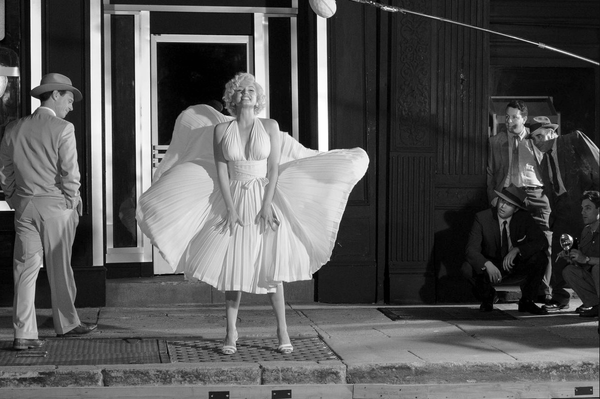The image is inescapable: Marilyn Monroe stands over a subway grate as blowing air lifts her white dress, revealing her naked legs. Andrew Dominik’s new film, Blonde, opens with this moment, originally staged for The Seven Year Itch (1955). Monroe’s face is dazzled, then blotted out, by flashing camera lights.
Though many critics insist on reading it as a straight biopic, Blonde, based on the novel of the same title by Joyce Carol Oates, is a horror film about the creation of the image of Marilyn Monroe. Those who scorn the film as “dehumanizing,” “cruel,” or “torture porn” can’t tolerate the ambivalence and ambiguity that Blonde depicts and demands.
Nowhere was this clearer than in the response to the film’s depiction of abortion. Caren Spruch, Planned Parenthood’s director of arts-and-entertainment engagement, has called it “anti-abortion propaganda” that “stigmatize[s] people’s health-care decisions.” In fact, the film merely frames the dilemmas surrounding abortion in sharp terms—neither making a case for or against. Reactions to Blonde show how, long after the demise of the Hays Code, our moral censors are outraged by the depiction of certain realities.
After a brief glimpse of the famous subway-grate image, we flash back to the childhood of Norma Jeane Baker, the girl who would one day be known as Marilyn Monroe. Norma Jeane’s mother, Gladys (played with manic depth by Julianne Nicholson), points to a black-and-white photograph over the bed: “That man is your father.” Shortly thereafter, they drive toward a blazing fire near the Hollywood sign, ash crackling and sparkling in the air. A policeman tells them to turn around and go home, but Gladys responds, “Actually, officer, I’d like to see hell close up. A preview.” Norma Jeane’s childhood, which occupies the first 17 minutes of the film, is shown in fever-dream clips of catastrophe. The image of her father hangs over Norma’s bed and appears again and again throughout the film. No matter how much attention she receives, she longs for recognition from this absent image.
Blonde pries open collective memories of the glamorous Marilyn Monroe to show how Norma Jeane’s ascent to fame was also a descent into oblivion. In a scene depicting Monroe’s screen test for Don’t Bother To Knock (1951), she tells the director that the script reminds her of Dostoevsky. He laughs this off, as though she couldn’t possibly have read such a writer. As she reads lines, tears streaming down her cheeks, she recalls, once again, an image of her father, which takes up the entire frame. We see the room from her point of view. “I know I could be Nell. I think I am Nell,” says Monroe, pleading for one more chance at the part. Later, as she leaves the room and the men discuss her performance, one of them says: “Look at the ass on that little girl.” Image overtakes person over and over again throughout the film’s nearly three hours.
Ana de Armas is mesmerizing as Norma Jeane, showing the complex ways she merges with and separates from the image of Marilyn Monroe in continuous plays of possession and exorcism. Monroe’s (fictional) polyamorous relationship with Charles Chaplin Jr. and Edward Robinson Jr. (played in darkly humorous fashion by Xavier Samuel and Evan Williams, respectively) is telling. In a surreal threesome scene, bodies merge, stretch, and melt like angelic funhouse mirrors. Suddenly the bed becomes the raging waterfall in the Monroe feature Niagara (1953). Like Marilyn, Chaplin and Robinson live in the shadow of their fathers’ images. About the duo, Monroe says, “They know I’m Norma, not Marilyn. They understand me.”
Morally outraged reviewers not only fail to read the film, but perform the very one-dimensional readings they claim to be offended by. Monroe’s abortion is shown in a bright white hospital room mirroring a film set. The talking fetus is not only her child, but the image she helped conceive: her twin, herself. What is art anyway if not the creation of “false images” that reveal a larger truth?
Joyce Carol Oates is right when she says Monroe went through worse than anything depicted in the film. Blonde isn’t a movie plagued by the “male gaze,” but one which shows the devouring eye of the camera. No one is immune. Everywhere: the violence and beauty of images. Norma Jeane gets devoured by Marilyn Monroe, as Marilyn Monroe devours us in a process that is by turns thrilling, horrifying, tragic, relatable, and implicating.
“Who here is above consuming an image or getting consumed by one?”
Watching Blonde, I felt near to the grotesque and eerie process of making images: frame, cut, flash, capture, point, shoot. Norma Jeane was a real person. “Marilyn Monroe” was not. Who here is above consuming an image or getting consumed by one? The image of Marilyn Monroe allowed Norma Jeane to be both more and less than she was. “Those who pretend to a high morality are no less immoral than anybody else; they’re just worse writers,” wrote Simone Weil. Likewise, those who think they are above devouring the image of Monroe aren’t more moral than Blonde, but they undoubtedly make worse art.
